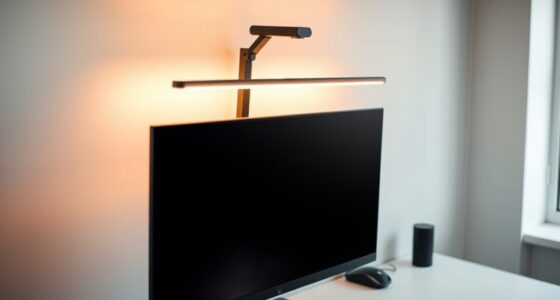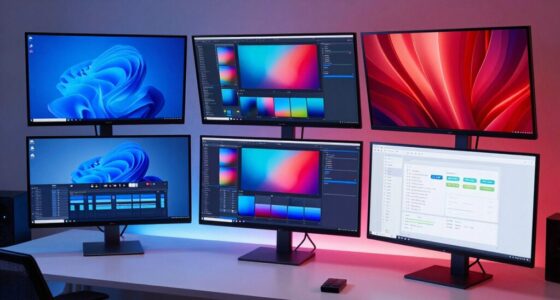If you’re looking for the best 4K HDMI capture devices for streaming and content creation in 2025, I recommend checking out options like the ClearClick 4K HD Video Capture Box, Guermok USB3.0 HDMI Capture Card, AXHDCAP 4K Capture Card, and versatile splitters like the OREI UHDS-104. These devices offer high-resolution support, low latency, and easy setup for various platforms. Keep in mind features like HDR support and compatibility with your systems. If you continue, you’ll discover the top choices tailored to your needs.
Key Takeaways
- Look for devices supporting true 4K60 HDR capture and pass-through for high-quality streaming in 2025.
- Prioritize plug-and-play models compatible with Windows, Mac, Linux, and gaming consoles for ease of use.
- Consider devices with low latency and reliable performance for live gaming and professional broadcasts.
- Check for multi-platform compatibility, including USB-A, USB-C, and smartphone support, to maximize versatility.
- Evaluate customer reviews for durability, software support, and troubleshooting assistance to ensure long-term reliability.
ClearClick 4K HD Video Capture Box

If you’re looking for a reliable 4K HDMI capture device that delivers high-quality footage without hassle, the ClearClick 4K HD Video Capture Box is an excellent choice. It supports true 4K60 resolution and HDR, making your streams vibrant and sharp. With HDMI input and pass-through, you can monitor in real-time without lag. It’s compatible with gaming consoles, cameras, and computers running Windows 10 or Mac OS X 10.10 or higher. Plug-and-play setup means you’re ready to go in minutes, and it works smoothly with popular software like OBS and Zoom. It’s perfect for creators who want professional-quality recordings with minimal fuss.
Best For: content creators, gamers, and professionals seeking high-resolution, reliable live streaming and recording solutions with easy setup and seamless software compatibility.
Pros:
- Supports true 4K60 resolution and HDR for vibrant, high-quality visuals
- Plug-and-play design ensures quick and easy setup without additional drivers
- HDMI pass-through allows real-time monitoring with no lag
Cons:
- Cannot record or stream from sources with HDCP content protection
- May require a powerful computer for optimal 4K60 streaming performance
- Limited advanced customization options in the software interface
OREI 4K HDMI Splitter (UHDS-104)

The OREI 4K HDMI Splitter (UHDS-104) stands out as an ideal choice for anyone who needs to duplicate a single HDMI source across multiple screens without extending desktop space. I find its ability to support up to 4K/60Hz with 18 Gbps bandwidth impressive, ensuring high-quality video and audio transmission. Its compact, durable metal enclosure makes it reliable for both permanent setups and on-the-go use. Designed for plug-and-play installation, it works well with high-quality HDMI cables under 30 feet. While it’s not an extender, it effectively mirrors content to four screens, perfect for presentations, home entertainment, or gaming setups.
Best For: individuals or professionals needing to duplicate a single HDMI source across multiple screens for presentations, home entertainment, or gaming setups.
Pros:
- Supports ultra HD 4K/60Hz resolution with 18 Gbps bandwidth for high-quality audio and video.
- Compact, durable metal enclosure ensures reliability and heat dissipation.
- Easy plug-and-play installation compatible with high-quality HDMI cables under 30 feet.
Cons:
- Does not extend desktop space; only mirrors content across multiple screens.
- Performance can be affected by cable quality, length, or connection order, requiring careful setup.
- Not suitable for long cable runs beyond 30 feet, which may limit placement options.
Capture Card for Nintendo Switch and Consoles (HDMI to USB 3.0)
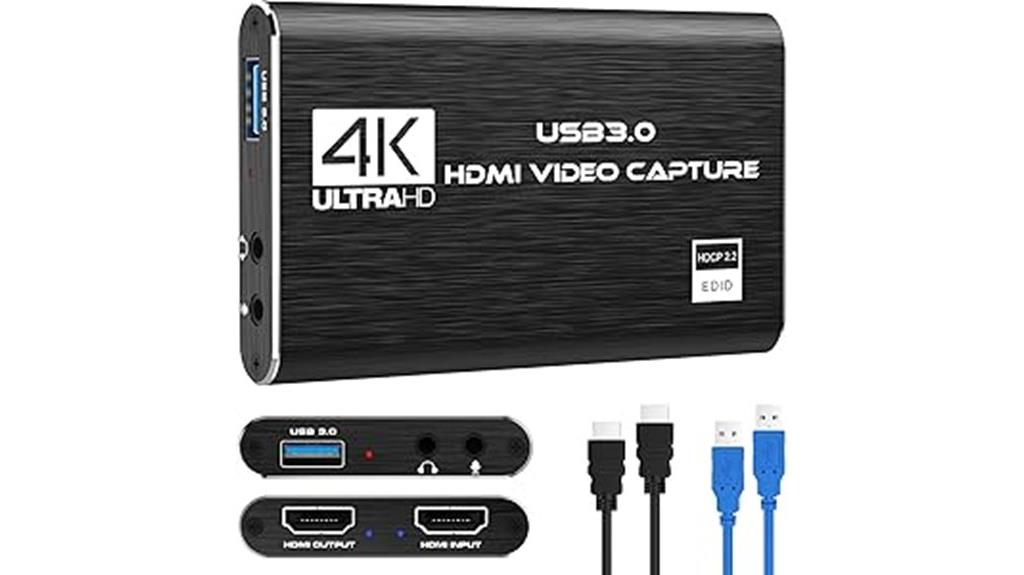
This capture card stands out as an excellent choice for gamers and streamers seeking a simple, reliable way to connect their Nintendo Switch and other consoles to a PC or Mac. It offers 4K HDMI pass-through at 60Hz and records in 1080P at 60FPS with minimal latency. Its plug-and-play design requires no drivers, making setup quick and straightforward. Compatible with Windows and Mac, it supports HDMI loop-out and microphone input for commentary. Lightweight and compact, it’s perfect for casual streaming, tutorials, or gameplay. Customers praise its affordability and ease of use, making it a solid, budget-friendly option for capturing high-quality gameplay without hassle.
Best For: casual gamers, streamers, and content creators seeking an easy-to-use, budget-friendly capture solution for Nintendo Switch and other consoles.
Pros:
- Plug-and-play design requires no drivers or external power for quick setup
- Supports 4K HDMI pass-through at 60Hz and records in 1080P 60FPS with minimal latency
- Compatible with Windows and Mac, suitable for streaming, recording, and live broadcasts
Cons:
- Recording capabilities limited to 1080P, not 4K for saved footage
- No USB-C support, relying solely on USB 3.0 connection
- Lacks advanced features like higher HDMI pass-through or professional-grade options
Guermok 4K USB3.0 HDMI Capture Card (Silver)
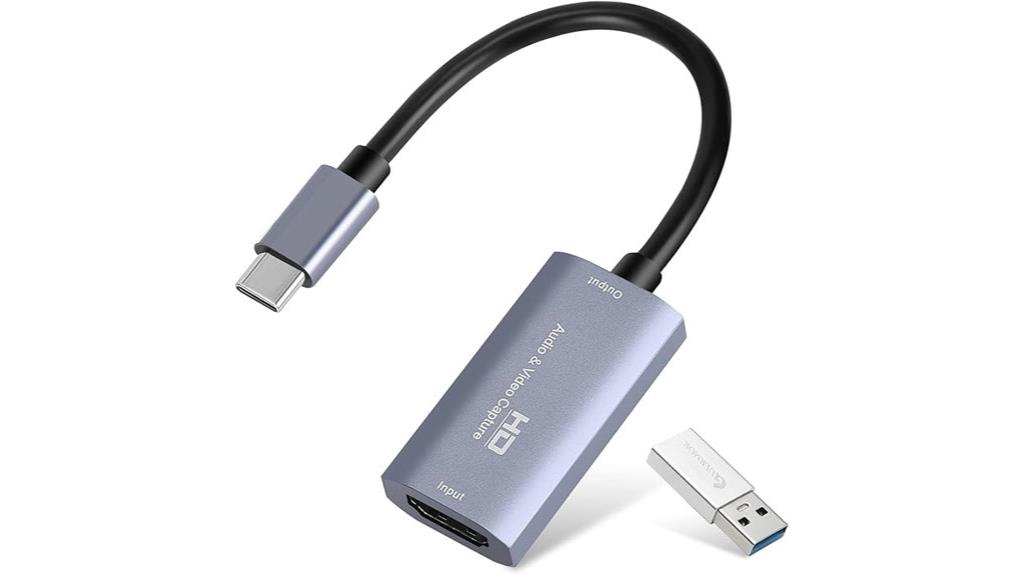
For streamers and content creators seeking a reliable, plug-and-play capture solution, the Guermok 4K USB3.0 HDMI Capture Card (Silver) stands out with its seamless 4K to 1080P support and broad device compatibility. It connects via USB 3.0 and supports input resolutions up to 4K@30Hz, delivering 1080P at 60FPS. Made of aluminum for heat dissipation, it ensures low latency during live streams, gaming, or recording. No external power or drivers are needed, making it highly portable. Compatible with Windows, Mac, Linux, Android, and various gaming consoles, it’s ideal for versatile content creation and online sharing.
Best For: content creators, streamers, and gamers seeking a reliable, portable HDMI capture solution compatible with multiple devices and platforms.
Pros:
- Supports 4K input at 30Hz and 1080P at 60FPS for high-quality streaming and recording
- Plug-and-play design with no external power or drivers required, ensuring easy setup and portability
- Compatible with a wide range of devices including PCs, Macs, Linux, Android, and gaming consoles like PS, Xbox, and Switch
Cons:
- Occasional recognition issues requiring reconnecting or restarting the device or software
- Some users experience audio delay (~130ms) that may need software adjustments for sync
- Does not always recognize as USB 3.0 and may require flipping the connector for proper detection
AXHDCAP 4K HDMI Video Capture Card
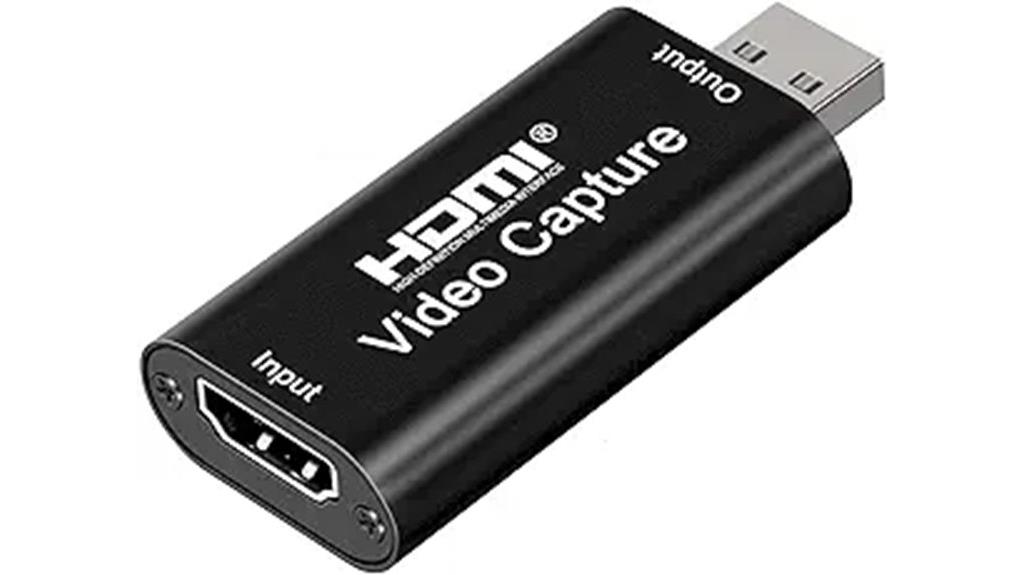
If you’re looking for an affordable yet capable capture device for casual streaming, the AXHDCAP 4K HDMI Video Capture Card delivers solid 1080p output from a 4K input, making it ideal for gaming, educational recordings, and conference setups. It supports HDMI input up to 4K 60FPS and USB output at 1080P, ensuring high-quality video and audio. Designed with durability and thermal dissipation, it’s compatible with Windows, macOS, Linux, and Android. Plug-and-play with no drivers needed, it’s easy to use. While it’s great for casual use, some users report latency issues during gaming, so it’s best suited for non-professional applications.
4K HDMI to USB Video Capture Card for Streaming and Gaming

Gamers and streamers seeking a reliable, plug-and-play device will appreciate the 4K HDMI to USB Video Capture Card, especially since it supports full HD recording at 1080p 30FPS without needing any driver installation. It easily captures HDMI video and audio signals, working smoothly with consoles like PS5, Xbox, Nintendo Switch, and other HDMI sources. Its compact design makes it perfect for both indoor streaming and outdoor setups. Compatible with Windows, Mac, and Linux, it enables real-time streaming on platforms like Twitch, YouTube, and OBS. While it lacks voice audio support, its high-quality output and simple setup make it a versatile tool for gamers and content creators.
Best For: streamers, gamers, and content creators seeking an easy-to-use, reliable device for capturing HDMI video and audio in full HD.
Pros:
- Plug-and-play setup with no driver installation required.
- Supports 1080p 30FPS full HD recording, ideal for high-quality streaming and sharing.
- Compatible with multiple platforms including Windows, Mac, and Linux, and works with popular streaming software like OBS and Twitch.
Cons:
- Does not support voice audio input; only HDMI audio signals are captured.
- Some users report recognition issues or device failure after prolonged use.
- Quality of the final image can depend on the viewing software, which may affect perceived output.
ClearClick 4K HD Video Capture Box 2.0
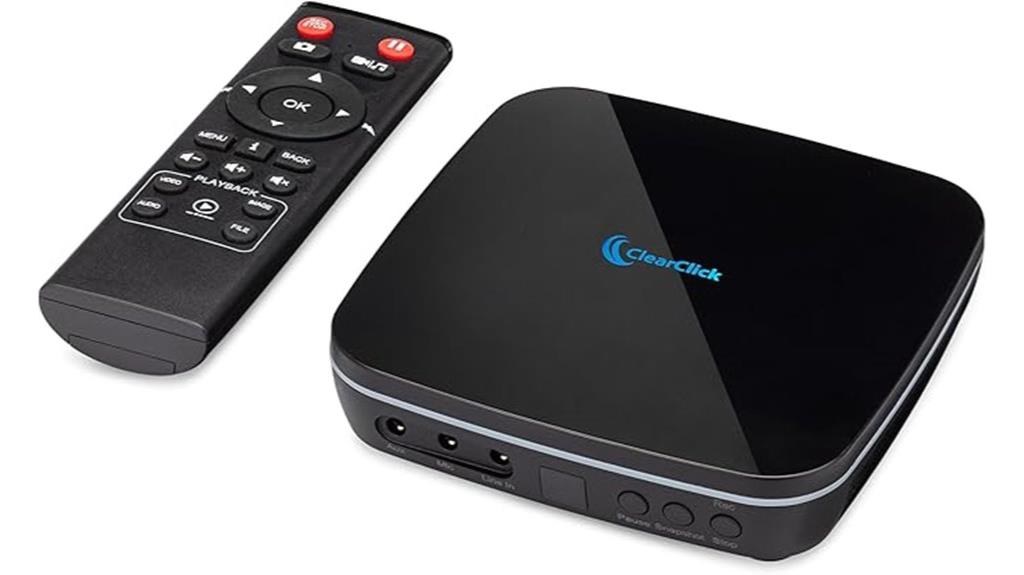
The ClearClick 4K HD Video Capture Box 2.0 is an excellent choice for users who want a standalone device capable of recording high-quality HDMI sources without needing a computer. It supports 4K 60 FPS input and records in 4K 30 FPS, with pass-through HDMI output for viewing while recording. You can save files directly to USB drives, MicroSD cards, or USB hard drives, all in MP4 format. It’s perfect for capturing gameplay, vintage camcorder footage, or media devices, provided they aren’t HDCP protected. Its plug-and-play design, remote control, and included cables make it straightforward to use, especially for casual and semi-professional applications.
Best For: casual and semi-professional users seeking a portable, standalone HDMI capture device for recording gameplay, vintage footage, or media content without needing a computer.
Pros:
- Supports 4K 60 FPS input and records in 4K 30 FPS for high-quality output
- Plug-and-play design with remote control and included cables for easy setup
- Compatible with various non-protected HDMI sources, including older camcorders and gaming consoles
Cons:
- Does not support HDCP-protected content, limiting use with streaming services and certain devices
- Customer support has been reported as limited and sometimes unhelpful for technical issues
- Compatibility issues may arise with certain PC configurations or sources with HDCP enabled
Ugreen 2K@30Hz Video Capture Card HDMI to USB 3.0 and USB C Capture Device

The Ugreen 2K@30Hz Video Capture Card is an excellent choice for content creators and streamers seeking reliable, high-quality video capture across multiple devices. It supports 4K input at 30Hz and 2K output at 30Hz, with backward compatibility for 1080p at 60FPS, making it versatile for different needs. Its low latency (around 130ms) ensures smooth live streaming and gaming. Compatible with USB-A and USB-C, it works seamlessly with laptops, consoles, cameras, and smartphones, supporting platforms like OBS, Twitch, and YouTube. Its durable aluminum casing and plug-and-play design make it a practical, portable option for professional and casual use.
Best For: content creators, streamers, and gamers seeking reliable high-quality video capture across multiple devices and platforms.
Pros:
- Supports 4K input at 30Hz and 2K output at 30Hz with backward compatibility for 1080p at 60FPS, ensuring versatile performance.
- Compatible with both USB-A and USB-C devices, broadening usability across various hardware.
- Durable aluminum alloy casing with plug-and-play design provides portability, heat dissipation, and ease of use.
Cons:
- Does not support HDCP, requiring users to disable HDCP on some devices.
- Lacks power pass-through, which could limit convenience during extended use.
- Compatibility with newer iPhone models (e.g., iPhone 15/16) and certain USB-C ports may be limited or require verification.
4K HDMI Capture Card for Streaming

Looking for a reliable HDMI capture card that can handle high-quality streaming without complicated setup? The K HDMI Capture Card supports up to 4K 60fps input and Full HD 1080p 60fps capture, perfect for streaming, gaming, and live broadcasts. It’s compatible with Windows, Mac, and devices like Nintendo Switch, PS5, Xbox Series X/S, and cameras. Its plug-and-play design requires no drivers, making it easy for beginners and pros alike. It delivers crisp video, low latency, and real-time audio, with a built-in microphone input for commentary. Compact and reliable, it’s a solid choice for seamless, professional-grade streaming.
Best For: streamers, gamers, and content creators seeking high-quality, easy-to-use HDMI capture for live broadcasting and recording.
Pros:
- Supports up to 4K 60fps input and Full HD 1080p 60fps capture for professional-grade video quality
- Plug-and-play design with no drivers required, suitable for beginners and experienced users
- Compatible with a wide range of devices including gaming consoles, cameras, and computers
Cons:
- Some users have experienced compatibility issues with certain consoles like Nintendo Switch 2
- Occasional reports of devices not recognizing the capture card or streaming at lower frame rates
- Limited customization options and troubleshooting support for hardware or software conflicts
Video Capture Card, 4K HDMI to USB/USB C 3.0 Capture Device
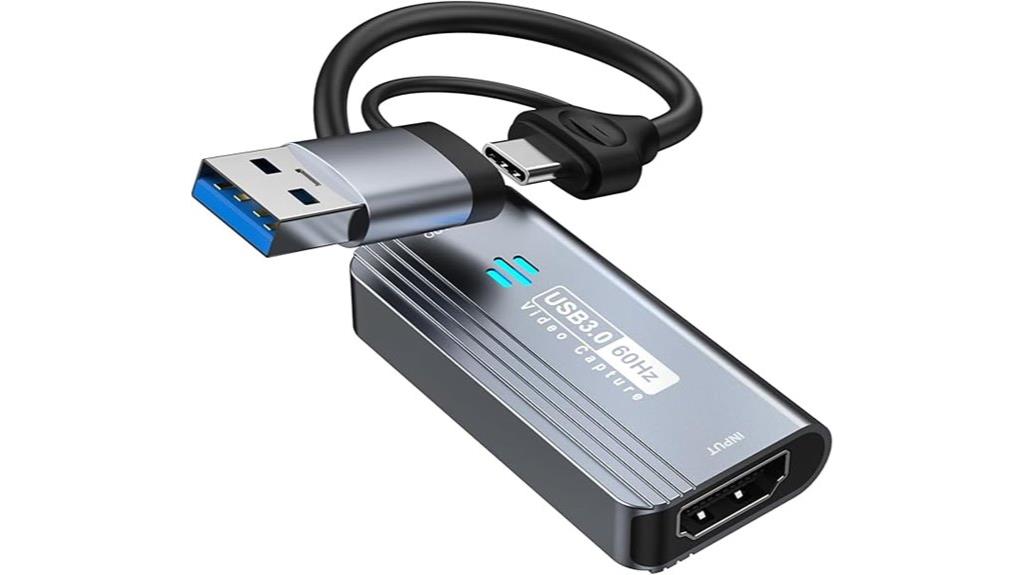
If you’re seeking a versatile and user-friendly capture device that works seamlessly with a wide range of devices, a Video Capture Card with 4K HDMI to USB/USB C 3.0 support is an excellent choice. It supports 1080P at 60FPS, making it perfect for streaming, gaming, teaching, or live broadcasts. With dual interfaces—USB-A and USB-C—it’s compatible with most laptops, tablets, and smartphones across Windows, Android, and MacOS. Connect your DSLR, camcorder, or gaming console like PS5, Switch, or Xbox to capture high-quality video and audio simultaneously. It’s straightforward to set up, delivers low latency, and is suitable for professional or hobbyist use.
Best For: streamers, gamers, and content creators seeking an affordable, versatile 4K HDMI capture device compatible with multiple platforms and devices.
Pros:
- Supports 1080P at 60FPS for high-quality streaming and recording
- Dual interface (USB-A and USB-C) for broad device compatibility
- Plug-and-play setup with low latency, suitable for professional and hobbyist use
Cons:
- Potential overheating during extended use, which may cause device failure
- Occasional lag issues in fast-paced gaming sessions
- Lacks features like charging while in use or advanced cooling options
Video Capture Card for Streaming and Gaming

For streamers and gamers seeking high-quality, low-latency capture, a dedicated video capture card is essential. This device supports 4K HDMI input with 60Hz loop-out and outputs 1080P at 60FPS or 2K at 30FPS, ensuring smooth streaming and recording. It features multiple ports, including HDMI pass-through, USB 3.0, and mic-in for commentary. Compatible with Windows, macOS, Linux, and Android, it works with gaming consoles, webcams, and streaming software like OBS. Made of durable aluminum, it offers stable, heat-managed performance with minimal latency, making it a versatile choice for both gaming and professional streaming.
Best For: streamers, gamers, and content creators seeking high-quality, low-latency video capture and streaming capabilities across multiple devices and platforms.
Pros:
- Supports 4K HDMI pass-through with 60Hz, ensuring high-resolution output for smooth gaming and streaming.
- Compatible with a wide range of operating systems and devices, including Windows, macOS, Linux, Android, and gaming consoles.
- Made of durable aluminum alloy for effective heat dissipation and stable performance during long use.
Cons:
- Does not support HDR passthrough for HDMI output, which may require additional splitters for HDR content.
- Some users report occasional issues with HDMI HDR passthrough or TV blackouts during use.
- Customer ratings average around 4.1 stars, indicating some users experience compatibility or setup challenges.
Cam Link 4K External Capture Card for Streaming and Recording
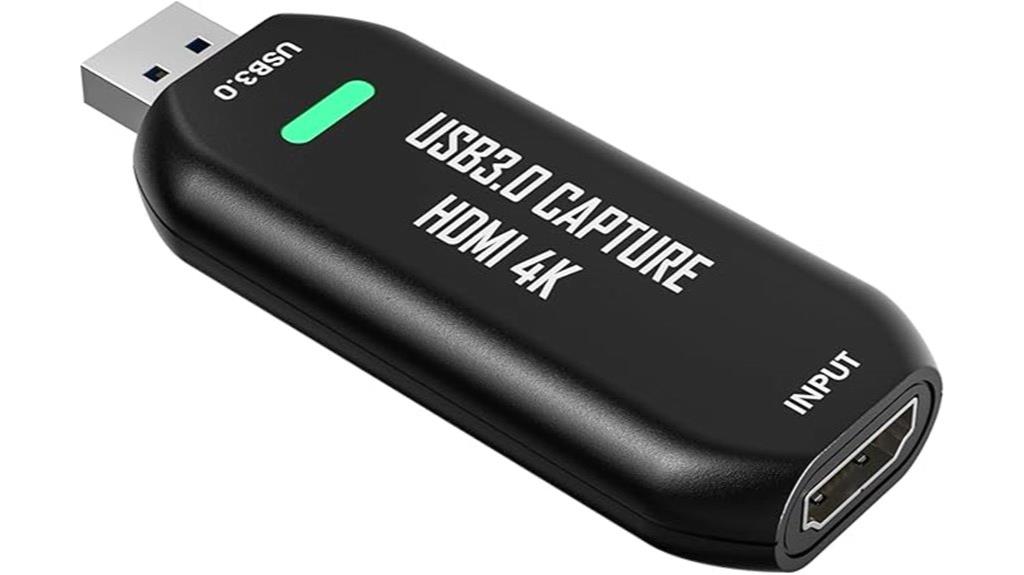
The Cam Link 4K External Capture Card stands out as an excellent choice for streamers and content creators who demand high-quality, low-latency video transmission. It easily turns DSLR, camcorder, or sports cameras into professional webcams for Mac or PC, supporting live streaming, recording, and broadcasting on platforms like YouTube, Twitch, and Facebook. With support for up to 1080p60 and 2K50 resolution, it delivers near real-time audio-video sync with ultra-low latency. Its plug-and-play design means no drivers are needed—just connect and stream. Compact and lightweight, it’s perfect for gaming, online teaching, and video conferencing, offering reliable performance and stunning image quality.
Best For: content creators, streamers, and gamers seeking high-quality, low-latency video capture for live streaming, recording, and broadcasting across platforms like YouTube, Twitch, and Facebook.
Pros:
- Supports up to 1080p60 and 2K50 resolution with near real-time audio-video sync
- Plug-and-play design with no driver installation required, easy setup
- Compact, lightweight, and compatible with various HDMI output devices such as cameras, game consoles, and DVD players
Cons:
- May require additional USB extension cables due to limited space and port accessibility
- Some devices might benefit from dedicated USB power supply for optimal performance
- Limited information on advanced customization or settings for professional use
Newhope 4K HDMI to USB C Capture Card for Gaming and Streaming

The Newhope 4K HDMI to USB C Capture Card stands out for its seamless compatibility with a wide range of devices, making it an excellent choice for gamers and streamers seeking high-quality, low-latency recording. Supporting 4K HDMI input and converting signals to USB-C 3.0, it handles up to 3840×2160@30Hz input and delivers 1080P 60fps output. Its plug-and-play setup requires no drivers, and it works smoothly with OBS, VLC, and other software. With real-time preview and ultra-low latency, it ensures smooth streaming and recording from consoles, cameras, or smartphones. Compact and reliable, it’s perfect for professional and casual content creators alike.
Best For: gamers, streamers, and content creators seeking high-quality, low-latency HDMI capture from various devices for streaming and recording purposes.
Pros:
- Supports 4K HDMI input and 1080P 60fps output for high-quality video.
- Plug-and-play setup with no driver installation required, compatible with major streaming software.
- Compact, portable design with ultra-low latency and reliable performance during extended use.
Cons:
- Limited to 30Hz at 4K input, not suitable for ultra-high-definition or 4K recording beyond 30Hz.
- Some users have reported hardware failures or connectivity issues without proper setup.
- Does not support ultra-high-definition or 4K output at higher frame rates, limiting use for advanced professional applications.
Video Capture Card for Streaming and Gaming (4K HDMI/1080P 60FPS)

If you’re serious about streaming or gaming in 4K, a capture card that supports 4K HDMI pass-through and 1080P 60FPS recording is essential. The Fulfalic Video Capture Card offers this with 4K HDMI loop-out and 2K30 capture, ensuring smooth gameplay and high-quality streams. It supports USB 3.0 for reliable data transfer, real-time capture, and low latency, making it perfect for competitive gaming and content creation. Its compatibility with Windows, Mac, Linux, Android, and popular devices like PS5 and Switch, plus easy plug-and-play setup, makes it a versatile choice for streamers seeking quality and stability.
Best For: streamers, gamers, and content creators seeking high-quality 4K passthrough and reliable 1080P 60FPS recording for professional streaming and gaming setups.
Pros:
- Supports 4K HDMI pass-through and 1080P 60FPS recording for smooth gameplay and streaming
- Plug-and-play setup compatible with Windows, Mac, Linux, Android, and popular gaming consoles
- Compact, durable aluminum alloy design with minimal latency for real-time capture
Cons:
- May require manual audio source configuration in streaming software like OBS
- Lacks included proprietary software for advanced features
- Potential HDCP restrictions could limit usage with certain protected content
4K HDMI Video Capture Card for Streaming and Recording
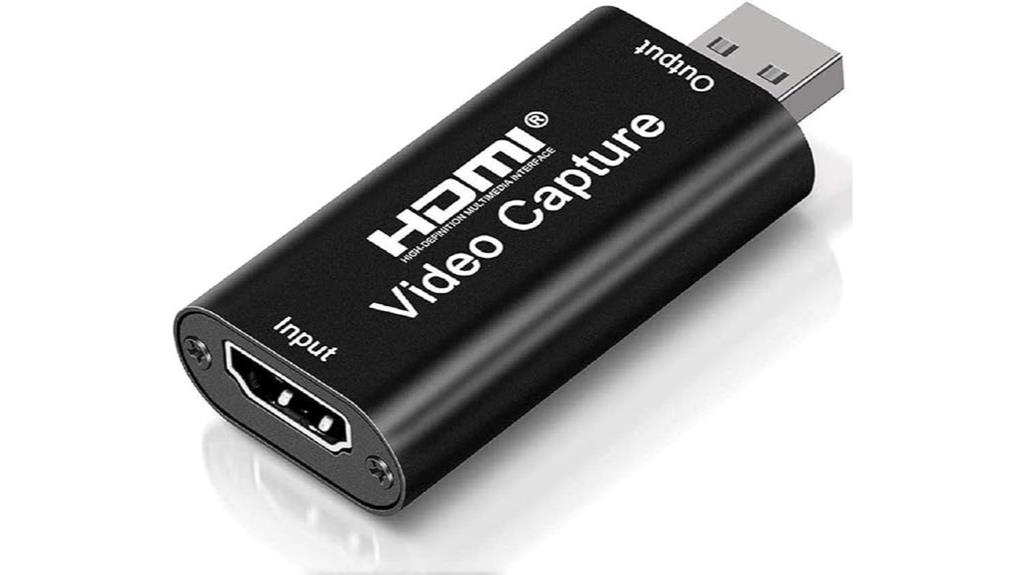
For streamers and content creators seeking high-quality, hassle-free recording and live streaming, the K HDMI Video Capture Card stands out with its support for up to 4K@60Hz input and 1080p@60Hz output. It allows direct recording to hard disks with no delay, making it perfect for devices like PS4, Switch, and more. Compatible with Windows, Android, and macOS, it features USB 2.0 high-speed transfer for real-time streaming with low latency. Its plug-and-play design requires no drivers or external power, and it can capture both video and audio simultaneously, providing a simple, portable solution for professional or casual content creation.
Best For: content creators, gamers, and streamers seeking high-quality, hassle-free recording and live streaming with 4K support.
Pros:
- Supports up to 4K@60Hz input and 1080p@60Hz output for high-definition recording and streaming
- Plug-and-play design with no driver installation or external power required for easy setup
- Compatible with Windows, Android, and macOS, ensuring versatile use across devices
Cons:
- Occasional issues with audio stability and artifacts like scanlines during downscaling from 4K
- Some users experience audio crackling or cutouts during extended recordings
- Limited to 4K input but outputs only 1080p, which may be a drawback for those requiring full 4K output
Factors to Consider When Choosing 4K HDMI Capture Devices

When selecting a 4K HDMI capture device, I concentrate on how effectively it functions with my current gear and the resolutions it accommodates. I also evaluate how much delay it causes and how simple it is to configure. Finally, I review content protection restrictions to make certain my recordings remain within legal limits.
Compatibility With Devices
Choosing the right 4K HDMI capture device hinges on guaranteeing it’s compatible with your existing hardware and software. First, check that the device supports your input resolution and frame rate, whether it’s 4K@60Hz or 1080p@60FPS, to ensure smooth capture. Next, confirm compatibility with your operating system—Windows, macOS, Linux, or Android—so setup is hassle-free. It’s also essential to verify that the device connects properly to your hardware, like gaming consoles, cameras, or PCs, via HDMI, USB, or USB-C ports. If you plan to capture encrypted media or streaming content, make sure it supports HDCP. Finally, guarantee the device plays well with your preferred streaming or recording software, such as OBS or VLC, to avoid any technical hiccups during your sessions.
Supported Resolutions and Frame Rates
Supported resolutions and frame rates are vital factors because they directly impact the quality and smoothness of your captured video. Higher resolutions like 4K at 60Hz deliver sharper images, but they demand more bandwidth and processing power, which can affect device performance. Frame rates such as 30Hz or 60Hz influence how fluid the motion appears; 60Hz provides smoother gameplay and fast-paced content. Some devices support variable frame rates, allowing you to match the source content for better results. It’s essential to verify the capture device’s maximum supported resolution and frame rate align with your needs. Failing to do so may limit your video quality or cause compatibility issues during streaming or recording. Choosing the right combination ensures peak performance and professional results.
Latency and Processing Speed
Latency and processing speed are essential factors because they directly affect how smoothly your video streams and gameplay appear. Lower latency, typically under 30 milliseconds, ensures real-time streaming and gaming without noticeable delays, which is critical for maintaining viewer engagement and gameplay responsiveness. Processing speed, measured in frames per second (FPS), determines how quickly video data is captured, encoded, and transmitted, impacting overall responsiveness. Devices supporting HDMI pass-through with minimal delay help keep live feedback intact, preventing lag during gameplay or broadcasts. High-performance capture cards use optimized hardware and software algorithms to reduce encoding and buffering times, boosting processing speed. Ultimately, these factors influence the synchronization of audio and video signals, fundamental for professional-quality streaming and interactive applications.
Content Protection Limits
Content protection, especially HDCP (High-bandwidth Digital Content Protection), plays a essential role in determining whether a 4K HDMI capture device can record or stream certain sources. Many devices can’t handle HDCP-encrypted content, resulting in black screens or no signal detection when connected to protected sources like streaming services, Blu-ray players, or gaming consoles. To capture protected content, you often need to disable HDCP settings, but some hardware limits this option or doesn’t support it at all. Devices that lack HDCP support typically display errors or blank screens, making them unsuitable for capturing premium media. Knowing whether a capture device supports HDCP is critical to avoid compatibility issues and ensure smooth recording or streaming of your desired sources.
Ease of Setup
Choosing a 4K HDMI capture device that’s easy to set up can save you time and frustration. I look for plug-and-play devices that don’t require driver installations, so I can get started quickly. Clear instructions or manuals help streamline the process, especially if I’m new to streaming. Compatibility with Windows, macOS, or Linux ensures I can use the device across different systems without hassle. Features like automatic hardware recognition and simple configuration of resolution and input sources make setup straightforward. I also prefer devices with minimal connection steps, such as a single USB port and HDMI pass-through, which reduces clutter and complexity. Overall, an easy setup means less troubleshooting and more time focusing on creating content.
Portability and Size
When selecting a 4K HDMI capture device, portability and size are key factors that can considerably impact your setup and workflow. Smaller devices, usually under 5 inches, are easier to carry, making them perfect for on-the-go streaming or recording sessions. Lightweight models, often weighing less than a pound, help reduce fatigue during long sessions and are ideal for mobile setups or fieldwork. Compact designs with minimal bulk fit well into tight spaces or portable rigs without sacrificing features. Devices with foldable or detachable cables further enhance portability by reducing size and preventing cable tangling during transport. Ease of connection and disconnection is also essential, especially for live situations or frequent location changes, ensuring your setup remains quick and hassle-free.
Software Compatibility
Have you checked if your 4K HDMI capture device works smoothly with your operating system and preferred software? Compatibility is essential for a hassle-free experience. Confirm the device supports your OS, whether it’s Windows, macOS, Linux, or Android, to avoid setup issues. Verify it works seamlessly with your chosen streaming or recording software like OBS, VLC, or proprietary apps—this guarantees smooth integration. Also, see if the device requires specific drivers or is plug-and-play; driver dependencies can complicate setup. Additionally, verify that it handles your desired resolution and frame rate, such as 4K60Hz or 1080P60, within your software environment for maximum video quality. Finally, consider HDCP support, which can restrict recording protected sources, affecting your content options.
Budget and Value
Budget and value are essential factors because a higher price doesn’t always guarantee better performance, but spending too little can lead to disappointment. When choosing a 4K HDMI capture device, I consider its overall cost relative to features, build quality, and performance. Cheaper options may record in 1080p and lack advanced features like HDR or multi-device support, which could limit your setup. Investing a bit more often yields better durability, lower latency, and more reliable long-term performance—especially for professional use. I also check if the device includes useful accessories like HDMI cables or remote controls, as these add to worth. Beware of very low-priced models, which might have higher failure rates or limited customer support, impacting their long-term worth. Finding a balance between cost and features ensures you get the best bang for your buck.
Frequently Asked Questions
How Do I Ensure Compatibility Between My Gaming Console and Capture Device?
To guarantee compatibility between my gaming console and capture device, I always check the device’s supported inputs and outputs, making sure they match my console’s HDMI ports. I also verify the device’s resolution and frame rate capabilities align with my console’s settings. Reading reviews and consulting the manufacturer’s specs helps me confirm that everything works smoothly. If needed, I use adapters or upgrade my hardware for seamless compatibility.
What Is the Latency Impact of Different 4K HDMI Capture Devices?
Did you know that some 4K HDMI capture devices have latency as low as 2 milliseconds? That’s nearly imperceptible and ideal for streaming. When I look at different devices, I notice that premium models often offer lower latency, which helps keep my gameplay smooth and my audience engaged. So, if latency matters to you, investing in a higher-quality capture device can make a real difference in your streaming experience.
Are There Specific Software Requirements for Using These Capture Devices?
When it comes to software requirements for 4K HDMI capture devices, I’ve found that most need compatible streaming or recording software like OBS Studio or Streamlabs. You should verify your system drivers are up to date and that the device’s drivers are properly installed. Some devices are plug-and-play, but others might require specific software setups. Always check the manufacturer’s guidelines to guarantee smooth, hassle-free operation.
How Do I Troubleshoot Common Connection or Recording Issues?
When troubleshooting connection or recording issues, I start by checking all cables and ensuring they’re securely connected. I also update my device drivers and streaming software to the latest versions. If problems persist, I test the device on another port or computer to rule out hardware faults. Restarting my system and adjusting settings like resolution or bitrate often helps resolve glitches quickly.
What Are the Best Storage Options for High-Quality 4K Recordings?
Think of your storage as the vault for your precious recordings. I recommend using fast SSDs for 4K files—they’re like a superhighway for data, ensuring quick access and transfer speeds. External SSDs or high-capacity NVMe drives are top choices, especially when paired with reliable backup solutions like cloud storage or RAID setups. This way, your high-quality captures stay safe, accessible, and ready for editing or sharing.
Conclusion
Just like the heroes in our favorite stories, choosing the right 4K HDMI capture device can elevate your streaming journey from ordinary to legendary. Whether you’re capturing epic gaming moments or creating stunning content, the right gear makes all the difference. Remember, it’s not just about the device, but the passion and vision you bring to your craft. So, pick wisely and let your story unfold with clarity and confidence, just like a hero in their prime.


